How Big Do Black Magic Elephant Ear Plants Get
Elephant ear plants bring to mind lush, tropical forests, adding drama to both gardens and containers. The most recognized forms have heart- or arrow-shaped leaves (often oversized) with decorative veining, inspiring the common name elephant ears. No plant satisfies the craving for a taste of the tropics like elephant ear plants. Popular in Victorian times, they have enjoyed a rebirth in the recent craze for zone-denying exotic plants.
COMMON TYPES OF ELEPHANT EAR PLANTS
- CALADIUM
- COLOCASIA
- ALOCASIA
- XANTHOSOMA
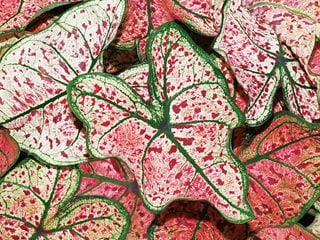
Heart to Heart™ 'Splash of Wine'. Photo by Proven Winners.
Zones:
10-11
Exposure:
Sun or shade depending on the variety
Soil:
Moist and acidic
Height:
6 inches to 3 feet
Spread:
Up to 2 feet
Caladium plants, sometimes called angel wings, are well suited for small gardens or growing indoors. Natives of South America, they offer an incredible range of colors, including green, white and red/pink.
Learn more about growing and caring for caladiums.
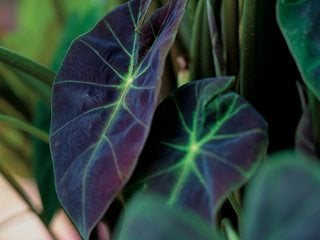
Colocasia Esculenta Illustris. Photo by: Proven Winners.
Zones:
7-12
Exposure:
Full sun to part shade
Soil:
Medium to wet, organically rich
Height:
3 to 10 feet
Spread:
2 to 10 feet
Originating in tropical parts of Asia and India, Colocasia plants like it warm and humid. Their leaves point downward and they have edible tubers, called taro. Their size makes them a great specimen plant. If you're lucky, yours may produce calla lily-like flowers.
Warning: Certain Colocasia species are considered invasive along the Gulf Coast.
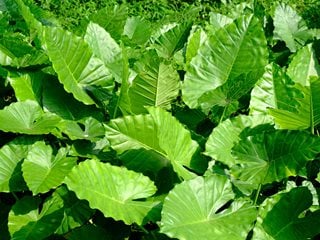
Photo by: Daniel Fung / Shutterstock.
Zones:
7-11
Exposure:
Part shade to full shade
Soil:
Moist, but well-drained, organically rich
Height:
2 to 6 feet
Spread:
2 to 6 feet
Hailing from subtropical Asia and parts of Australia, Alocasia plants are sometimes called African mask plant. Unlike other elephant ears, their leaves point upwards and their tubers aren't edible.
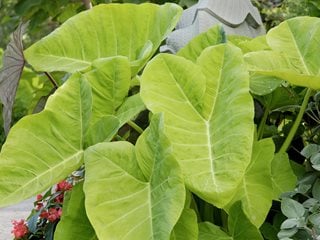
Photo by: Garden World Images Ltd / Alamy Stock Photo.
Zones:
8-10
Exposure:
Part shade/full shade
Soil:
Moist, but well-drained and organically rich
Height:
2 to 4 feet
Spread:
1 to 4 feet
Natives of tropical America, Xanthosoma plants like very warm and humid weather. Like Colocasia, the tubers of Xanthosoma are edible. This type of elephant ear is less common for growning in home gardens than the other types.
Love interesting foliage? JOIN 95,000 other plant lovers who learn more about plants, landscape design, and garden problem solvers each week.
ELEPHANT EAR PLANT CARE
High drama and bold texture are the signature benefits of showcasing elephant ears in a garden or container. Growing them is simple — they like filtered sun or shade and rich, moist soil. They're grown from tuberous rhizomes and can reach impressive sizes quickly.
Zones:
Fully hardy in Zones 10 to 11. Elephant ears will only truly thrive in warmer areas similar to their native humid climates of Southeast Asia, and with daytime temperatures of 70 to 85F, and nights no lower than 60F. They can be grown in cooler areas, but will need to be replanted each year.
Overwintering:
In colder zones, the tuberous rhizomes can be dug up and stored over winter.
After a frost, do the following:
- Cut back foliage
- Dig up rhizomes
- Allow to dry for a few days
- Store in an open container with peat moss or dry potting soil barely covering the rhizome
- Keep them cool (45 to 55 degrees), and dry
For winter protection outdoors, cover the base of the plant with 4 to 12 inches of mulch.
Exposure:
Most prefer filtered sun or shade, but some tolerate full sun. In general, green types can take higher light levels; darker-leaved ones need more filtered light or shade.
Soil:
Elephant ears need rich soil that is moist (not saturated), but well-drained. Most don't like wet feet, though a few are tolerant of wet conditions—like the big-leaved colocasias you might see in water gardens. A general rule is big, green elephant ears are practically indestructible and can tolerate variable moisture conditions; dark-leaved types will suffer if over watered and can stay dry for several days.
Watering:
To prevent disease problems, water in the morning so they go into the night dry. If possible, water from below at the root zone rather than from above, to keep water off the leaves.
Fertlizer:
They're not heavy feeders. Apply a slow-release fertilizer at planting time, following package directions. If foliage shows yellowing, it's probably a micronutrient deficiency. A fertilizer with micronutrients can be applied, or sprinkle Epsom salts around the base of each plant on a monthly basis.
ELEPHANT EAR VARIETIES TO GROW
Their rapid growth creates a show even during a short growing season, making them worthy as one-shot annuals of benefit to northern gardeners. But among the 70 or so species and their cultivars, there are small, medium, and large sizes; leaf shapes from wide hearts to slim arrowheads; colors accentuated with bright veining and spots; and textures from slick and glossy to thick and waxy. While their use in gardens has given them their current cachet, many also make good houseplants.
Swipe to view slides
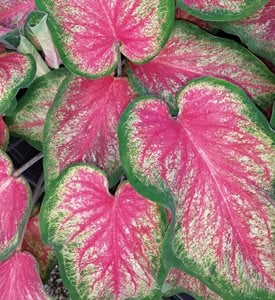
Photo by: Proven Winners.
HEART TO HEART™ 'TICKLE ME PINK' — Buy now from Proven Winners
Caladium hortulanum
This caladium with pink, white, and green foliage can be grown in sunny to shady locations, as well as indoors as a houseplant. Grows 15 to 20 inches tall and 8 to 10 inches wide.
Hardy in Zones 10 to 11, otherwise grown as an annual.
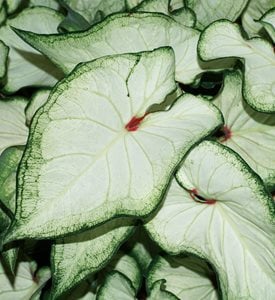
Photo by: Proven Winners.
HEART TO HEART™ 'WHITE WONDER' — Buy now from Proven Winners
Caladium hortulanum
An elegant choice that grows 15 to 20 inches tall and 8 to 10 inches wide. This strap-leaf variety can withstand full sun or shade.
Hardy in Zones 10 to 11, otherwise grown as an annual.
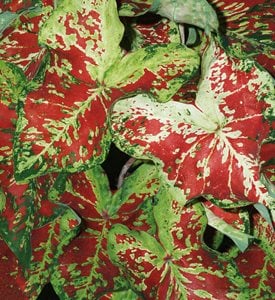
Photo by: Proven Winners.
HEART TO HEART™ 'MESMERIZED' — Buy now from Proven Winners
Caladium hortulanum
A fancy red form with contrasting shades of green and orange. Grow outside in shade to sun, or indoors on a sunny windowsill.
Hardy in Zones 10 to 11, otherwise grown as an annual.
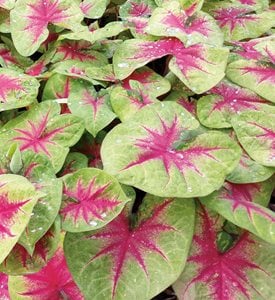
Photo by: Proven Winners.
HEART TO HEART™ 'LEMON BLUSH' — Buy now from Proven Winners
Caladium hortulanum
This fancy-leaved variety prefers shade to part shade and grows 15 to 20 inches tall and 10 to 14 inches wide. It has a lemony-green leaves with hot pink center and veins.
Hardy in Zones 10 to 11, otherwise grown as an annual.

Photo by: Proven Winners.
HEART TO HEART™ 'SPLASH OF WINE' — Buy now from Proven Winners
Caladium hortulanum
This fancy-leaf variety grows to 20 inches tall and 14 inches wide and likes conditions on the shadier side. It can also be grown as a houseplant.
Hardy in Zones 10 to 11, otherwise grown as an annual.

Photo by: Proven Winners.
COLOCASIA ESCULENTA 'ILLUSTRIS' — Buy now from Proven Winners
This variety grows three to five feet tall in the garden. Its leaves have dramatic green veining against a black background. Illustris loves wet conditions and is also adaptable as a houseplant.
Hardy in Zones 10 to 11, otherwise grown as an annual.
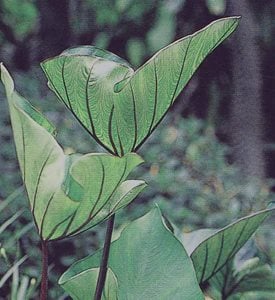
Photo by: Proven Winners.
COLOCASIA COFFEE CUPS — Buy now from Proven Winners
This award-winning, easy-care variety grows three to five feet tall in the garden. Its dark green foliage and height make it a perfect thriller centerpiece when used in containers.
Hardy in Zones 8 to 11.
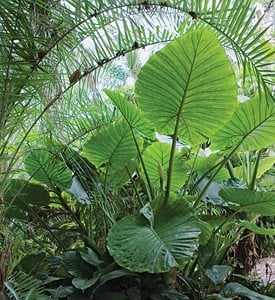
Photo by: Chelsea Stickel.
ALOCASIA 'CALIDORA'
Big, dramatic hybrid of A. gagaena and A. odora, reaching five to seven feet tall with rounded, sky-pointing, dark green leaves nearly four feet long and three feet wide. Forms a "trunk" and thick sturdy stalks. Easy and fast in a partly sunny location.
Hardy in Zones 9 to 11.
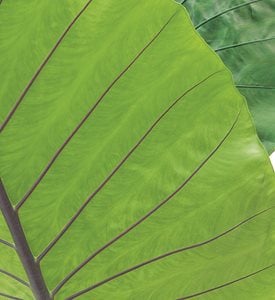
Photo by: Pam Mclean.
A. MACRORRHIZA 'BLACKSTEM'
A large elephant ear, three to five feet tall, with upward-pointing, two-foot wide, dark green leaves, slightly ruffled along the edges. Leaf stalks and veins on the leaf undersides are a striking ebony purple. Prefers part sun to shade.
Hardy in Zones 9 to 11.
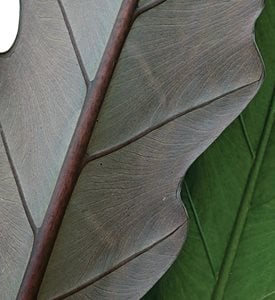
Photo by: Rob Cardillo.
A. LAUTERBACHIANA
A native of New Guinea previously included in the genus Xenophya. Long, narrow, swordlike leaves, green with a bluish cast on top, mauve-purple beneath, and scalloped on the edges, are unusual for an alocasia and make a dramatic vertical statement. Can reach five feet in height.
Hardy in Zones 9 to 11, maybe Zone 8 with extra winter protection.
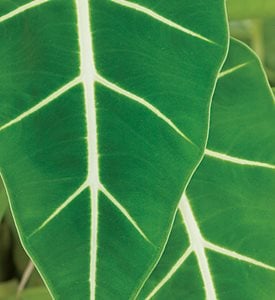
Photo by: Pam Mclean.
A. MICHOLITZIANA 'FRYDEK'
Velvety emerald-green leaves with prominent white veins are eight to 12 inches long and arrowhead shaped. Grows two to three feet tall in the shade garden or a container. Attractive purple-banded leaf stalks add extra interest.
Hardy in Zones 9 to 11; also makes an easy houseplant.
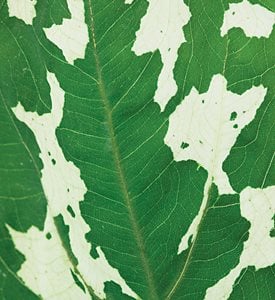
Photo by: Pam Mclean.
A. 'HILO BEAUTY'
Striking elephant ear with a mosaic pattern of green, cream and yellow on its foliage. Plant usually stays under three feet tall, with leaves one foot long and six inches wide. A robust grower for a garden with shade or filtered light. Can also be grown in a terrarium while a young plant then moved outdoors or into a container.
Root-hardy as far north as Zone 8; goes dormant at 45 degrees.
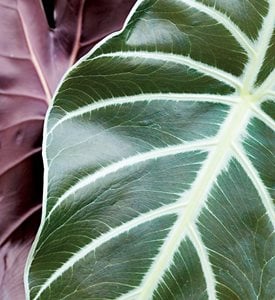
Photo by: Pam Mclean.
A. 'PURPLE PRINCE'
A hybrid elephant ear with waxy, arrowhead-shaped, purplish green leaves with iridescent veining and eggplant-colored undersides, one to two feet long. Can reach three to four feet. Prefers shade or bright diffused light.
Hardy in Zones 9 to 11.

Photo by: Pam Mclean.
A. RUGOSA
Even when you touch this elephant ear, it's hard to believe it's real. Thick, quilted leaves with nubby texture feel like plastic. A smaller alocasia, typically eight to 12 inches tall.
Hardy to Zone 9 outdoors but makes an easy houseplant (or terrarium specimen) since it is slow growing and can take the low light and dry air typical of indoor situations.
DESIGNING WITH ELEPHANT EAR PLANTS
- Add oversized elephant ears to the perennial border for a dramatic focal point. A plant with large green leaves also gives the eye a rest amidst masses of colorful flowers.
- Alocasias make good companions and dramatic centerpieces in mixed containers, used with other foliage plants and flowering annuals that like filtered sunlight and moist soil. Use one of the larger types in a big pot for a showstopper.
- Purple-foliaged species combine well with silver, pink and chartreuse plants.
- Combine elephant ears with other tropical-looking plants like cannas, bananas, variegated tapioca, caladiums, and coleus for a summer jungle garden.
- An alocasia in a container placed out in the garden can be a movable focal point, and can hide the bare spot left when spring-blooming bulbs go dormant.
FREQUENTLY ASKED QUESTIONS
Are elephant ear plants poisonous?
Elephant ear plants are poisonous if ingested in large quantities. The plant's leaves and stems contain oxalic acid, which can cause serious illness in children or pets. However, cooking renders the toxins harmless and many cultures have safely eaten them for years (specifically taro root, or Colocasia esculenta). See more Common Poisonous Plants for Dogs and Cats.
Do elephant ear plants bloom?
Yes, they can bloom; however, it is not common or predictable. Some gardeners report blooms (called spathes) in spring after bringing their plants outdoors and fertilizing, while other gardeners never see them bloom. These plants are grown primarily for their tropical foliage.
Are elephant ear plants perennials?
Most are perennials in Zone 9 and warmer, where they will come back each summer. If gardening in cooler zones, you can treat them as annuals or dig up the tubers before the first frost and keep them in a cool, dry place over winter.
When do elephant ear plants sprout?
Elephant ears usually sprout three to eight weeks from planting. Sprouting occurs when the weather begins to warm in spring. They will sprout faster in warmer climates than in cooler climates. To speed up the process, you can start them inside and move them outdoors once it warms up.
Why are my elephant ear plants turning yellow?
If the leaves are turning yellow, it could mean there is a problem. Try changing the amount of sunlight or water the plant gets and possibly apply a fertilizer. Alternatively, the plant may be going dormant for the season. Cut back the yellow leaves and wait for it to return next spring.
Do elephant ears spread?
Some elephant ear plants spread along the ground, while others grow in clumps. Runners will quickly form a large mass of plantings, which can be good or bad. If you're worried about them spreading out of control, choose a clumping variety.
Can elephant ears grow in full sun?
Full sun is not ideal for most—they grow best in bright but indirect sunlight. Too much sunlight can burn the leaves, while too little sunlight can cause yellowing. There are certain varieties that can tolerate full sun.
Can you plant elephant ear plants in a pot?
Yes, elephant ears can be planted in pots. Since they grow quite large, you'll want to select a container that is roomy and stable. Container-grown plants can easily be moved inside when cold weather arrives and enjoyed as houseplants.
Why are my elephant ear plants drooping?
Elephant ears may droop because there is a problem. Try adjusting the amount of light or water or applying a fertilizer. Another reason for drooping is that the large leaves become too heavy. Staking can help support the plants and prevent drooping. Plants will also droop if temperatures are too cold for them.
Last updated: September 17, 2021
RELATED:
20 Great Shade Plants
Top Foliage Plants for Your Garden
Tropical Gardens
20 Best Summer Bulbs to Grow
Hostas
How Big Do Black Magic Elephant Ear Plants Get
Source: https://www.gardendesign.com/plants/elephant-ear.html